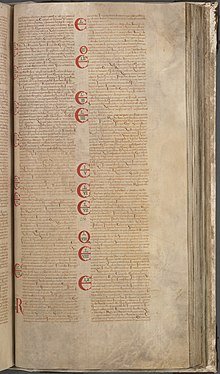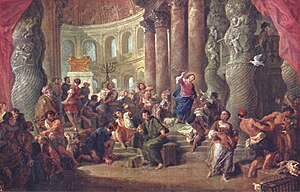Mark 11
| Mark 11 | |
|---|---|
 The Latin text of Mark 8:13–11:10 in Codex Gigas (13th century) | |
| Book | Gospel of Mark |
| Category | Gospel |
| Christian Bible part | New Testament |
| Order in the Christian part | 2 |
Mark 11 is the eleventh chapter of the
Text
The original text was written in Koine Greek. This chapter is divided into 33 verses.
Textual witnesses
Some early manuscripts containing the text of this chapter are:
- Codex Vaticanus (325-350; complete)
- Codex Sinaiticus (330-360; complete)
- Codex Bezae (~400; complete)
- Codex Alexandrinus (400-440; complete)
- Codex Ephraemi Rescriptus (~450; complete)
Timescale
Verses 1-11 reflect the events commemorated by Christians on Palm Sunday. Verses 12-19 record actions of "the next day", and end that evening. Verses 20-33 commence early (Greek: πρωῒ, prói), the following morning.[2] Tuckett argues that Mark has "very likely" compressed a series of events into a single week whereas it is more plausible to assume they took place over a longer period of time.[1]
Triumphal entry into Jerusalem

| Gospel of Mark |
|---|
Jesus and his
Jesus instructs two unnamed disciples to go ahead to the town and collect a colt, by which he almost assuredly means a young
They bring the colt back to Jesus and put their
- "Hosanna! Blessed is he who comes in the name of the Lord! Blessed is the coming kingdom of our father David! Hosanna in the highest!"[5]
The Textus Receptus repeats the words ἑν ὀνόματι Κυρίου (en onomati kuriou, "in the name of the Lord") in verse 10 as well as verse 9:
- "Blessed is the kingdom of our father David that comes in the name of the Lord!"[6]
The ancient
The quotation from the Psalms is significant, as the composition of the Psalms is traditionally ascribed to King David. The word ὡσαννά, (Hosanna, "save us please") is derived from Aramaic (הושע נא) (see
This event is celebrated by Christians as Palm Sunday, as the Gospel of John says the branches were taken from palm trees.[9]

Verse 11
- And Jesus went into Jerusalem and into the temple. So when He had looked around at all things, as the hour was already late, He went out to Bethany with the twelve.[10]
He goes into the city and checks out the Temple. Where this entry took place is unknown, some believing it was through what is now called
The fig tree and the money changers
As they leave Bethany next day, Jesus, who is hungry, sees a fig tree at (or from) a distance and goes over to see if it has figs.


They reach Jerusalem and Jesus goes straight to the Temple,
Verse 17
- And he taught, saying unto them,
- Is it not written, My house shall be called of all nations the house of prayer?
- but ye have made it a den of thieves.[14]
- Cross reference: Luke 19:46
Jesus combines quotes from
The incident with the money changers is recorded in all the Gospels. The
According to the
- This would appear to have been on the first day of the week and on the 10th of Nisan, when, according to the Law, it was necessary that the paschal lamb should be purchased. It is therefore probable that the entry into Jerusalem was for this purpose. In making the purchase of the lamb a dispute appears to have arisen between Jesus' followers and the money-changers who arranged for such purchases; and the latter were, at any rate for that day, driven from the Temple precincts. It would appear from Talmudic references that this action had no lasting effect, if any, for Simon ben Gamaliel found much the same state of affairs much later (Ker. i. 7) and effected some reforms (see Derenbourg in "Histoire de la Palestine," p. 527). The act drew public attention to Jesus, who during the next few days was asked to define His position toward the conflicting parties in Jerusalem. It seemed especially to attack the emoluments of the priestly class, which accordingly asked Him to declare by what authority He had interfered with the sacrosanct arrangements of the Temple. In a somewhat enigmatic reply He placed his own claims on a level with those of John the Baptist — in other words, he based them on popular support.
The
The next morning they pass by the fig tree again and Peter notices that it is now "withered", and excitedly points it out to Jesus, who replies:
- Have faith in God,...I tell you the truth, if anyone says to this mountain, 'Go, throw yourself into the sea', and does not doubt in his heart but believes that what he says will happen, it will be done for him. Therefore I tell you, whatever you ask for in prayer, believe that you have received it, and it will be yours. (22-23)
Similar statements can be found, apart from the fig tree story, in
Some have argued that Jesus' action in regard to the fig tree seems
The fig tree is again mentioned in Mark 13:28 by Jesus as part of his
This section of Mark ends with verses 11:25–26 which are paralleled in Matthew 6:14–15 and Luke 6:37,11:4 which some have seen as a portion or a follow-on of the
Argument over Jesus' authority
Jesus then goes back to the Temple a third time, and as he walks through the Temple courts the priests, teachers, and elders come up to him and question his authority to do the things that he is doing. They are trying to get him to say that his authority comes from God and can therefore accuse him of blasphemy.
Jesus says that he will tell them if they answer him one question: "John's baptism — was it from heaven, or from men? Tell me!" (30) The priests are then trapped. Mark implies that they did not believe in John, so that if they answer from heaven people will ask why they did not believe John. If they answer from men, they would be in conflict with the people, who did believe in John. They therefore refuse to answer and accordingly so does Jesus. This allows him to make the priests look bad and incompetent and also allows him to imply to the people that his authority is from God without saying it.[citation needed]
This is the first time in Mark that the chief priests, members of the Sanhedrin, are presented as Jesus' opponents. His previous conflicts had been with the Pharisees and scribes or teachers of the law.[20] Jesus has several arguments with the Jewish authorities beginning here and lasting through chapter 12 in which they try to trip him up but continually fail.
Comparison with other canonical gospels
Matthew records these stories in chapter 21, with the differences that Jesus fights with the money changers the day He gets to Jerusalem and He heals several blind and lame people afterwards. Jesus curses the fig tree the next morning and it withers immediately.
Luke has all of this content in 19:28-20:8, except for the fig tree, and includes an explicit prediction by Jesus of Jerusalem's
John 12 has Jesus arrive in Bethany and have dinner with Lazarus and his sisters
See also
- Related Bible parts: Isaiah 56, Jeremiah 7, Matthew 21, Luke 19
References
- ^ a b c Tuckett, C. M., 57. Mark, in Barton, J. and Muddiman, J. (2001), The Oxford Bible Commentary, p. 908-9
- ^ Strong's Concordance, 4404. prói, accessed 2 April 2020
- ^ a b Brown et al., p. 620
- ^ Miller 39
- ^ (9-10)
- NU-Text
- ^ Bengel, J. A., Bengel's Gnomon of the New Testament on Mark 11, accessed 2 December 2017
- ^ Walter Bauer, Greek-English Lexicon of the NT
- ^ John 12:13
- ^ Mark 11:11: NKJV
- ^ Kilgallen 210
- ^ Maclear, G. F. (1893), Cambridge Bible for Schools and Collegeson Mark 11, accessed 30 June 2021
- ^ Mark 11:12–14
- ^ Mark 11:17 KJV
- ISBN 9780805401165.
- ^ Kilgallen 215
- ^ Catholic Online, Life of Jesus Christ, accessed 18 June 2017
- ^ Russell, B., Why I am not a Christian, accessed 18 June 2017
- ^ Jewish Encyclopedia: Lord's Prayer: "Accordingly Jesus said: "Whensoever ye stand praying, forgive, if ye have aught against any one; that your Father also which is in heaven may forgive you your trespasses" (Mark xi. 25, R. V.). It was this precept which prompted the formula "And forgive us our sins ["ḥobot"="debts"; the equivalent of "'awonot"="sins"] as we also forgive those that have sinned ["ḥayyabim"="those that are indebted"] against us." ... On closer analysis it becomes apparent that the closing verses, Matt. vi. 14-15, refer solely to the prayer for forgiveness. Consequently the original passage was identical with Mark xi. 25; and the Lord's Prayer in its entirety is a later insertion in Matthew. Possibly the whole was taken over from the "Didache" (viii. 2), which in its original Jewish form may have contained the prayer exactly as "the disciples of John" were wont to recite it."
- ^ Mark 2:16
Sources
- Brown, Raymond E., An Introduction to the New Testament, Doubleday 1997 ISBN 0-385-24767-2
- Brown, Raymond E. et al., The New Jerome Biblical Commentary, Prentice Hall 1990 ISBN 0-13-614934-0
- Kilgallen, John J., A Brief Commentary on the Gospel of Mark, Paulist Press 1989 ISBN 0-8091-3059-9
- Miller, Robert J., editor, The Complete Gospels, Polebridge Press 1994 ISBN 0-06-065587-9
External links
- Mark 11 King James Bible - Wikisource
- English Translation with Parallel Latin Vulgate
- Online Bible at GospelHall.org (ESV, KJV, Darby, American Standard Version, Bible in Basic English)
- Multiple bible versions at Bible Gateway (NKJV, NIV, NRSV etc.)
| Preceded by Mark 10 |
Chapters of the Bible Gospel of Mark |
Succeeded by Mark 12 |
